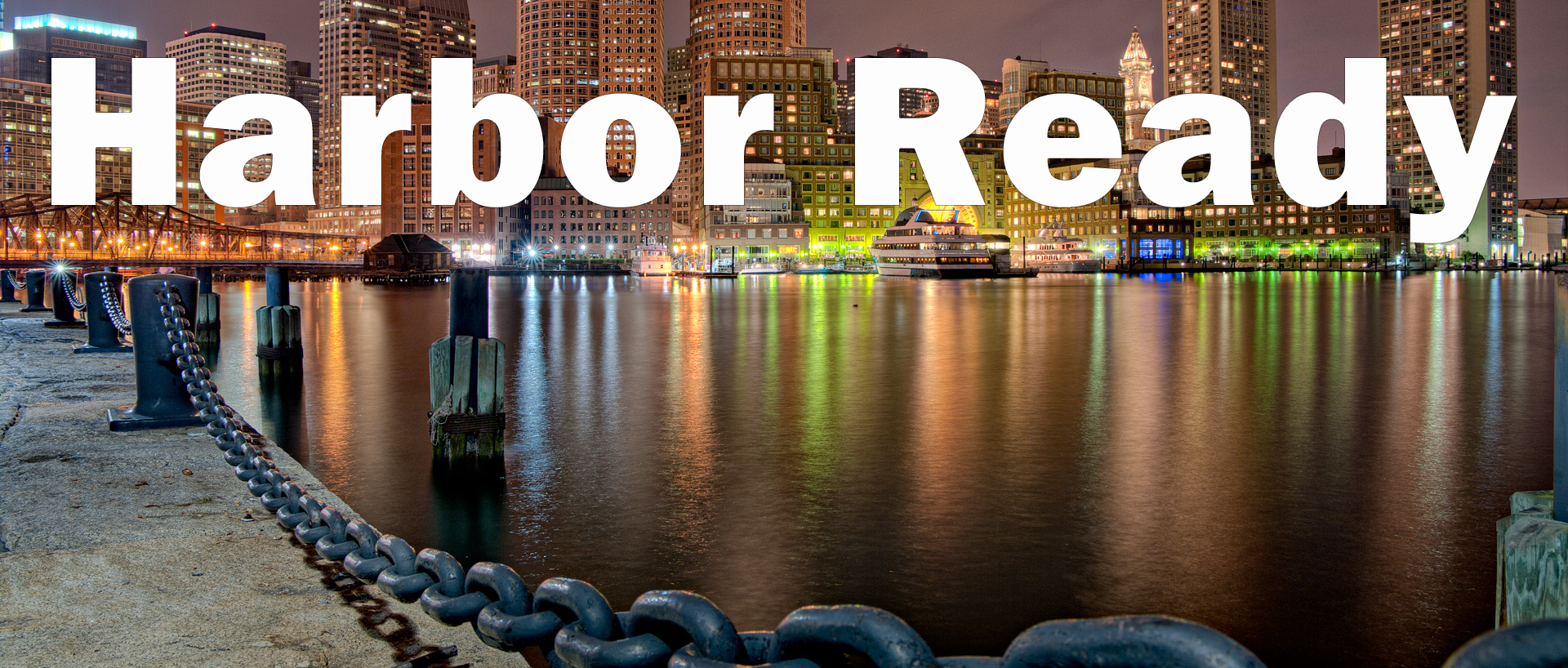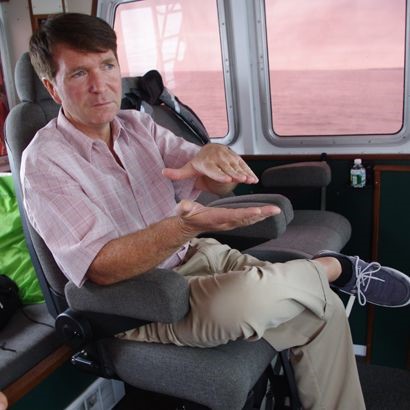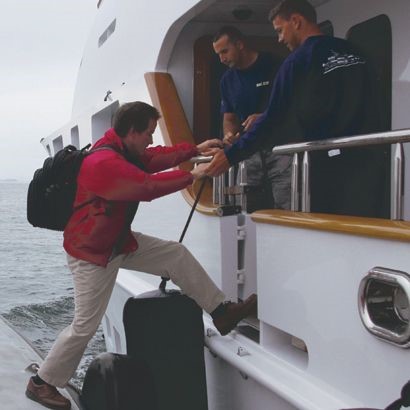Meet a few of the finest sailors in the world
By Rudi Anna

BOSTON– It’s dawn in the Boston Harbor. Roseate sunlight hangs heavily behind stretching patchworks of dark clouds crossing a vast ocean sky.
Thrumming duel-engines break the sea-scape serenity. A weathered-orange, 50-foot pilot boat called the Mystic zooms out toward the horizon, not to greet the rising sun, but to rendezvous with a waiting Irving oil tanker, that, from head on, juts out of the distant ocean waters like a lone tooth.
Finally, the Mystic pulls parallel with the ginormous tanker. At four-stories tall and almost 200-feet long, it’s over 10 times the pilot boat’s size. Both ships cruise alongside at 17 knots, or roughly 20 mph.
Inside the pilot boat, Gregg Farmer, a 53-year-old expert mariner, prepares to board the Irving tanker. He slides on a heavy Gore-tex jacket with life-vest inflation and a pair of thick rubber gloves. Over his shoulder, he slings an encased touch-screen laptop linked to a satellite in geosynchronous orbit that superimposes an image on a digital chart, showing the tanker’s position, course and speed.
Then things get a little old school.
From the tanker’s towering deck drops a rope ladder. Farmer steps out to his boat’s edge to make the climb. His gloved hand reaches for purchase on a wobbly rung, then the other hand. Dark blue water churns angrily below in the small gap between the vessels.
If he slips, he could die.
Farmer scampers up and into the waiting arms of two of the tanker’s crewmen, who hoist him up and over the side to safety.
Initial greetings ensue, very casual. As he moves, Farmer scans his new surroundings, making snap judgments and countless mental notes on ship conditions that over thirty years of training and experience have taught him to do. Crew leaders promptly guide him to the ship’s bridge.
“When I set foot on deck, I feel like I’m part of the vessel,” says Farmer, just moments before making the journey from the pilot boat to the tanker. “I can feel the motions of the ship. I can feel where it wants to go.”
Now at the bridge threshold, Farmer makes his entrance. The shipmaster greets him with reverence, almost thankful for his presence.
“She’s a little moody,” warns the shipmaster. “Hard to turn her at low speeds.”
Farmer considers the information seriously. He knows the behemoth he rides on weighs over 310,000 tons, and he’s commandeered one like it before. If it wants to go where he wants, great, but if it doesn’t, he knows what to do.
The laptop is flipped open, the monitor flashing on. Farmer checks it, makes a few clicks to set his bearings, and he’s ready.
And like that, the shipmaster turns the controls of a multi-million-dollar vessel over to Farmer. As thousands of ships, hundreds of thousands of passengers and millions more tons of cargo enter Boston waters each year, a licensed Harbor Pilot like Farmer is required on the bridge for all of them. These pilots are, in fact, gatekeepers of the harbor’s ocean commerce.
A maritime legacy dating back centuries, ancient Roman law required shipmasters to use a specialized sea captain known as a ‘pilot’, a title designated to the person on a vessel who had charge of directing its course when entering coastal waters. Pilots were specialized in that they possessed expert knowledge of the local aquatic terrain and failure to use them meant being imposed financial penalties and, in some countries, corporal punishment for the shipmaster if his vessel suffered damages.
The centuries passed, but the need for an organized pilot system, particularly in Europe, never waned. By the sixteenth century, piloting became an official aid to commerce for the Dutch. Amerigo Vespucci, the Italian explorer from whom America derives its name, became the Chief Pilot of Spain in 1508.
Nearer to our own shores, Patuxet native, Squanto, became New England’s earliest known pilot, albeit more by nature of forced servitude than noble calling, after being appointed by Plymouth Colony Governor William Bradford in 1622 to guide the British warship, the Swan, to shore in the New World.
“Squanto knew how to maneuver the dangerous shoulders and roaring breakers at the Cape’s elbow. It was only his third time, but that was three times more than anybody else on that ship had,” says Erik Ronnberg, an adjunct maritime curator at the Cape Ann Museum in Gloucester. “Under Squanto’s piloting stewardship, the Swan, though not without a few close calls, would land safely near Chatham for the first time. The colonists understood well the need for knowledgeable, well-practiced pilots.”
This need is especially true when faced with negotiating the unpredictable tidal treachery of Boston Harbor.
Back on the oil tanker, heading for its docking terminal in Revere, Farmer looks out the spanning bridge window. The Boston skyline rises prominently in the morning haze. Seagulls drift through the air. A United States Coast Guard patrol boat with a .50 caliber machine gun steel-bolted on its deck skips across the tanker’s bow; the gunner waves to Farmer, who returns the gesture.
“Slow ahead, five knots. Starboard, five,” Farmer commands, telling the engineer to ease it forward to that speed and to execute a five-degree turn to his right. Once the ship has been brought up and about, Farmer says, “Midships,” which means neutral rudder, or ‘straight ahead’.
For Farmer, threading million-dollar ships through the narrowest of clearances is just a normal day’s work. Earlier in the morning, around 2 a.m., he captained a 1,090-foot cargo ship’s departure out to sea with millions of dollars’ worth of South American-bound merchandise onboard.
At minimum, there’s at least one ship to guide a day and, at most, 15 or 16. Almost everything sailing into Boston, if the ship weighs over 350 gross tons, gets brought in by a pilot when the tide’s right. Even yachts, those SUV’s of the ocean, that exceed the weight limit, and many do, have to accept a pilot whether they want to or not.
Without harbor pilots escorting some 11.4 tons of cargo into and out of the port of Boston each year, there would not be enough gas for the region’s cars, salt for the roads, heating oil for its homes, or merchandise to buy at the shopping malls.
Since the passing of the Interstate Commerce Act of 1887, when the federal government allowed states to oversee their own commerce, every coastal state including Massachusetts has fashioned their own sets of rules and regulations to manage commercial traffic.
One of the outcomes of this legislation was allowing merchants and officials to take advantage of local expertise to guide large ships in and out of their ports.
Pilots are state commissioned, meaning a state appointed pilot commissioner selects who they want guiding these ships. In Boston, there are only nine pilots, and though it’s the largest port district in Massachusetts, their numbers are small compared to a place like New York City, which has over 60.

All Boston Harbor pilots possess the prestigious license of Unlimited Ocean Master, which means they can be a captain of literally any boat of any size. “Basically, we all hold the highest license a mariner can have,” says Farmer. It took him 10 years to obtain his license, considered fast by most standards.
The bulky Irving tanker trudges through the water, now reaching the ‘point of no return’. That’s when a ship is 1.5 miles outside the breakwater, where the narrow dredged channel begins and there’s no room to abort an approach. From here, Farmer will start steadily bleeding ship speed.
A pilot knows where all the out-of-sight hazards lay, where every island is, and they can navigate the narrow, oft-congested tidal current channels; their expert local knowledge of the coastal waters allows them to seek preferable anchorage, and it makes no difference the visibility level.
But Boston Harbor is very quirky with a unique set of idiosyncrasies and dangers. Some of them defy common sense.
“We don’t have enough water right now,” says Scott MacNeil, a harbor pilot who, at 48, is one of the youngest working in Boston. “Authorized depth is 40 feet, but we’re actually at 38 feet right now. The ground soaks it in, and it’s a constant battle. There are certain areas that have a tendency to shoal up and they need maintenance.”
Since Boston’s a tidal port, the Harbor tides range around ten feet, so all the factors affecting ocean depth must be taken into account, and these bits of information, once calculated, cannot be second guessed or misjudged. The consequences are too dire.
A big oil tanker like Irving’s brings 42 feet of draft, which means there is 42 feet of steel tanker hull moving below the water’s surface. That means it can only be moved when there’s a positive tidal change. The water must deepen to at least 45 feet or more for safe passage, and that only happens twice a day. Ship clearance protocols dictate that there must be at least three feet of space from keel to floor.
As the tanker passes through the harbor, it hugs the East Boston shoreline, where the channel is deeper. Two tugboats, the Justice and the Freedom, connect to the tanker by towlines at opposite ends of the big ship’s stern.
Once at the breakwater, two more tugs, the Liberty and the Harold Reinauer II, take positions on opposite ends of the bow. This is known as ‘team towing’, a strategy devised to guide large ships with more precision. If the rudder suddenly fails, the tugs will provide control.
The tanker has now entered the security zone, and law enforcement appears. No unauthorized vessels are allowed within 300 yards. Five small boats with whirring blue lights — the Coast Guard, city and state police, and Massachusetts Environmental Police among them — escort the tanker.
But Boston is a well-trafficked harbor, and other commercial ships with harbor pilots onboard have places to be. Enforced order, however, must reign supreme.
One of the police boats races out to intercept a mid-size container ship slowly closing in on the tanker’s stern. Another police boat heads off an outbound freighter on course to cross the tanker’s bow. There’s no cause for alarm, though. These are just precautions and formalities. Everybody seems to already know the routine. The oil-filled ship needs its space. They will wait their turn.
“They’re gonna have to anchor for a bit,” says Farmer about the other ships. “I have the tonnage, so I have the right of way. Unfortunately, we can’t hurry.”
Pilots represent the public’s interest because they can shut down, should they decide conditions unsafe for whatever reason, a commercial delivery which costs, depending on the cargo, a lot of money.
“It can be like hundreds of thousands of dollars, sometimes millions, whether it’s hauling cement, petrochemicals, tankers or even with a Queen Mary cruise ship,” says Dirk Coffman, 52, a pilot who graduated with Farmer from the Massachusetts Maritime Academy where many pilots get their early training, “and there’s no recourse, to us, commercially, for making that decision. That’s why it works. It’s safety first.”
In their rookie years, pilots earn north of $70,000, but older pilots can make around $300,000. “It’s not a bad sum, considering the risks,” says Coffman. Since 2006, six pilots have perished in the United States, all from drowning.

And dawn becomes mid-morning. Farmer’s been onboard the Irving tanker for two hours. Though they’ve just docked, it will take another 90 minutes to attach mooring lines.
Three of the tugs stick around, pushing against the starboard, bow and stern to hold the tanker in place as water pressure from other ships in the channel might cause the steel behemoth to move away from shore.
And the job is done. The next outbound, a cruise ship, will depart in two hours, the stakes will again be high, and Farmer, as sure as the sun’s eye cracks open the ocean line every morning, will be there.
###